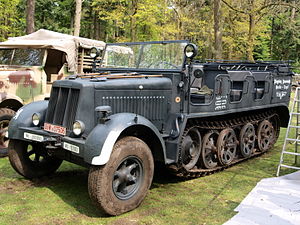SdKfz 7
| Sd.Kfz. 7 | |
|---|---|

Sd.Kfz. 7 on Militracks 2010, Overloon
|
|
| Type | Half-track artillery tractor |
| Place of origin | Nazi Germany |
| Service history | |
| In service | 1938 - 1945 (Nazi Germany) |
| Used by | Nazi Germany, Italy, Bulgaria, Yugoslav Partisans (captured) Czechoslovakia (postwar), Allies (postwar) |
| Wars | World War II |
| Production history | |
| Designer | Krauss-Maffei |
| Designed | 1934 |
| Manufacturer | Krauss-Maffei, Borgward, Österreichische Saurer-Werke AG, Breda (Breda 61) |
| Unit cost | 36,000 Reichsmark |
| Produced | 1938 - 1944 |
| No. built | 12,187 |
| Variants | Sd.Kfz. 7/1, Sd.Kfz. 7/2, Feuerleitpanzer auf Zugkraftwagen 8t, Breda 61 |
| Specifications | |
| Weight | 11.53 tonnes |
| Length | 6.85 m (22 ft 6 in) |
| Width | 2.35 m (7 ft 9 in) |
| Height | 2.62 m (8 ft 7 in) |
| Crew | 1 driver |
| Passengers | 11 |
|
|
|
| Engine | Maybach HL 62 TUK, six-cylinder petrol 135 PS, (133 hp, 99 kW) |
| Power/weight | 12.1 hp/tonne |
| Payload capacity | 1,800 kg |
| Suspension | Torsion bar |
| Fuel capacity | 215 liters |
|
Operational
range |
250 km (160 mi) on roads 120 km (75 mi) off-road |
| Speed | 50 km/h (31 mph) on roads |
The Sd.Kfz. 7 was a half-track military vehicle used by the German Wehrmacht Heer, Luftwaffe and Waffen-SS during the Second World War. (Sd.Kfz. is an abbreviation of the German word Sonderkraftfahrzeug, "special purpose vehicle". A longer designation is Sd.Kfz. 7 mittlerer Zugkraftwagen 8t, "medium towing motor vehicle 8t".)
Development of the Sd.Kfz. 7 can be traced back to a 1934 Wehrmacht requirement for an eight-tonne (7.87 tons) half-track. Various trial vehicles were built by Krauss-Maffei from 1934 to 1938. The production vehicle first appeared in 1938 and was intended to be used mainly as the tractor for the 8.8 cm FlaK gun and the 15 cm sFH 18 150 mm howitzer. Production was stopped in 1944. The vehicle was made by Krauss-Maffei in Munich, the Saurerwerke in Vienna and the Borgward works at Bremen. Because of its heavy power, it often found use as a recovery vehicle.
The vehicle could carry gun crews of up to 12 men in theatre-type seats. Under the seats was storage room for various tools, and the whole vehicle was spacious enough to carry their kit. The rear of the vehicle housed an enclosed compartment for storage of ammunition, though a second ammunition carrier was desirable. The tractor could tow loads up to 8,000 kg (17,600 lb) in weight. Most were fitted with a winch that could pull up to 3450 kg. It had a payload of 1800 kg. The windscreen was able to fold down and a canvas roof could be erected. A number were also constructed with a hard top, but this was less common in service. A later simplified type appeared with a timber frame truck-type layout, the ammunition being stored behind the driver's station and the gun crew having space on wooden benches behind.
The running gear consisted of two front wheels with hydro-pneumatic tires for steering and a track each side with 14 road wheels — 7 per side, overlapping and interleaved in the common Schachtellaufwerk design for German half-tracks — on each side of the vehicle; a drive sprocket was located at the front of each track system. Minor variations on the track and road wheel design and manufacture took place throughout the course of service, some being combined in the field as repairs took place. In 1943, the Maybach HL 62 engine was replaced with Maybach HL 64.
...
Wikipedia
